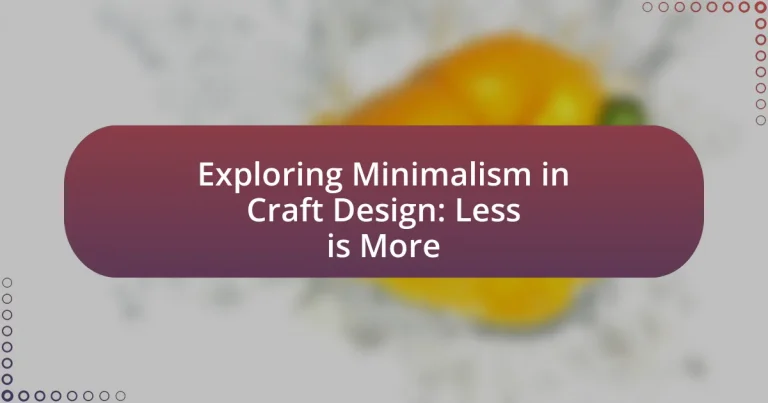Minimalism in craft design is an aesthetic and philosophical approach that emphasizes simplicity, functionality, and the reduction of unnecessary elements. This article explores the emergence of minimalism as a design philosophy, its historical influences from movements like Bauhaus and Japanese aesthetics, and its core principles, including the concept of “less is more.” It examines how minimalism differs from other design philosophies, its significance in contemporary craft design, and its impact on sustainability and consumerism. Additionally, the article discusses the application of minimalism across various craft disciplines, the benefits and challenges of adopting this approach, and practical tips for artisans looking to embrace minimalist principles in their work.

What is Minimalism in Craft Design?
Minimalism in craft design is an aesthetic and philosophical approach that emphasizes simplicity, functionality, and the reduction of unnecessary elements. This design philosophy prioritizes clean lines, a limited color palette, and the use of natural materials, aiming to create objects that are both beautiful and practical. The roots of minimalism can be traced back to the mid-20th century, influenced by movements such as Bauhaus and Japanese design principles, which advocate for the idea that “less is more.” This approach not only enhances the visual appeal of crafted items but also encourages mindfulness and intentionality in both creation and consumption.
How did Minimalism emerge as a design philosophy?
Minimalism emerged as a design philosophy in the mid-20th century as a reaction against the complexity and ornamentation of previous artistic movements. This movement was influenced by the Bauhaus and De Stijl movements, which emphasized simplicity, functionality, and the use of industrial materials. Minimalism sought to strip away excess and focus on the essence of design, leading to a clean, uncluttered aesthetic that prioritizes form and function. The rise of Minimalism was also marked by the 1960s art scene, where artists like Donald Judd and Agnes Martin created works that embodied these principles, emphasizing the importance of space and the viewer’s experience.
What historical movements influenced Minimalism in craft design?
Minimalism in craft design was influenced by several historical movements, notably the Bauhaus, De Stijl, and Japanese aesthetics. The Bauhaus movement, founded in Germany in 1919, emphasized functional design and the unity of art and technology, advocating for simplicity and the elimination of unnecessary ornamentation. De Stijl, emerging in the Netherlands in the early 20th century, promoted abstraction and minimalism through geometric forms and primary colors, influencing the visual language of minimalism. Additionally, Japanese aesthetics, particularly the principles of wabi-sabi, which values simplicity and the beauty of imperfection, significantly shaped minimalist philosophy in craft design. These movements collectively contributed to the ethos of minimalism, emphasizing clarity, functionality, and the reduction of excess in design.
How does Minimalism differ from other design philosophies?
Minimalism differs from other design philosophies by emphasizing simplicity and the elimination of excess elements. While many design philosophies incorporate decorative features and complexity, Minimalism focuses on functionality and the essential qualities of objects, often using a limited color palette and clean lines. This approach is rooted in the belief that less is more, allowing for a clearer expression of purpose and form. Historical movements, such as the Bauhaus and De Stijl, also sought simplicity but often included more color and geometric abstraction, whereas Minimalism prioritizes a stark aesthetic that strips away non-essential components.
What are the core principles of Minimalism in craft design?
The core principles of Minimalism in craft design include simplicity, functionality, and the use of natural materials. Simplicity emphasizes the reduction of unnecessary elements, focusing on clean lines and uncluttered forms. Functionality ensures that each piece serves a purpose, marrying aesthetics with usability. The use of natural materials highlights authenticity and sustainability, often favoring organic textures and colors that resonate with the environment. These principles are rooted in the belief that less is more, allowing the essence of the craft to shine through without distraction.
How does the concept of ‘less is more’ apply to craft design?
The concept of ‘less is more’ in craft design emphasizes simplicity and functionality, prioritizing essential elements over excessive ornamentation. This principle allows designers to create pieces that are not only aesthetically pleasing but also practical, enhancing user experience. For instance, the Bauhaus movement, which emerged in the early 20th century, championed minimalism by advocating for designs that serve their purpose without unnecessary embellishments, demonstrating that effective design can be achieved through restraint.
What role does functionality play in minimalist craft design?
Functionality is central to minimalist craft design, as it prioritizes utility while eliminating unnecessary elements. This approach ensures that each crafted item serves a specific purpose, enhancing user experience and practicality. For instance, the Bauhaus movement, which emphasized functional design, demonstrated that aesthetic simplicity could coexist with effective usability, leading to iconic pieces that remain relevant today. By focusing on functionality, minimalist craft design not only meets the needs of users but also promotes sustainability by reducing waste through thoughtful, purposeful creation.
Why is Minimalism significant in contemporary craft design?
Minimalism is significant in contemporary craft design because it emphasizes simplicity and functionality, allowing artisans to focus on the essential qualities of materials and forms. This design philosophy encourages the reduction of unnecessary elements, which enhances the aesthetic appeal and usability of crafted objects. For instance, the rise of minimalism in the 20th century, influenced by movements such as Bauhaus and Japanese aesthetics, has led to a renewed appreciation for craftsmanship that prioritizes clean lines and thoughtful design. This approach not only resonates with modern consumers seeking clarity and purpose in their possessions but also aligns with sustainable practices by promoting the use of fewer resources.
How does Minimalism respond to consumerism and excess?
Minimalism directly counters consumerism and excess by advocating for simplicity and intentionality in consumption. This philosophy encourages individuals to prioritize quality over quantity, focusing on essential items that bring value and joy, rather than accumulating unnecessary possessions. Research indicates that minimalism can lead to reduced stress and increased satisfaction, as individuals experience greater clarity and purpose in their lives. By promoting a lifestyle that values experiences over material goods, minimalism challenges the societal norms of consumer culture, which often equates happiness with the accumulation of wealth and possessions.
What impact does Minimalism have on sustainability in craft design?
Minimalism significantly enhances sustainability in craft design by promoting the use of fewer resources and reducing waste. This design philosophy encourages artisans to focus on essential elements, leading to the creation of products that require less material and energy in their production processes. For instance, a study published in the Journal of Cleaner Production highlights that minimalist designs often utilize sustainable materials and prioritize durability, which extends the lifespan of products and minimizes environmental impact. By emphasizing simplicity and functionality, minimalism not only fosters a more sustainable approach to craft design but also aligns with consumer preferences for eco-friendly products.

How is Minimalism applied in various craft disciplines?
Minimalism is applied in various craft disciplines by emphasizing simplicity, functionality, and the elimination of excess. In woodworking, artisans focus on clean lines and natural materials, creating pieces that highlight the beauty of the wood itself without unnecessary embellishments. In ceramics, minimalism manifests through the use of simple forms and muted colors, allowing the texture and shape to take center stage. Textile crafts often adopt minimalism by utilizing a limited color palette and straightforward patterns, which enhance the tactile quality of the fabric. Additionally, in graphic design, minimalism prioritizes clarity and space, using fewer elements to convey messages effectively. This approach across disciplines not only fosters a sense of calm and order but also encourages a deeper appreciation for craftsmanship and materiality.
What are some examples of Minimalism in textile design?
Examples of Minimalism in textile design include the use of solid colors, simple geometric patterns, and natural materials. Designers like Muji emphasize functionality and simplicity, often utilizing organic cotton and linen in their collections. Additionally, brands such as Nitori focus on clean lines and understated aesthetics, showcasing textiles that prioritize texture over elaborate designs. The Bauhaus movement also influenced minimalism in textiles, promoting the idea that form follows function, which is evident in the work of designers like Anni Albers, who created woven textiles with a focus on simplicity and utility.
How do color and texture contribute to minimalist textile designs?
Color and texture significantly enhance minimalist textile designs by creating visual interest while maintaining simplicity. In minimalist design, a limited color palette often emphasizes neutral tones, which fosters a sense of calm and clarity, allowing the viewer to focus on the form and function of the textile. For instance, the use of monochromatic shades can create depth and dimension without overwhelming the senses.
Texture, on the other hand, adds tactile quality and richness to minimalist textiles, enabling them to convey warmth and comfort despite their simplicity. The interplay between smooth and rough textures can evoke emotional responses and enhance the overall aesthetic. Research indicates that textiles with varied textures can engage users more effectively, as they invite touch and interaction, which is crucial in minimalist design where every element serves a purpose.
Thus, the strategic use of color and texture in minimalist textile designs not only adheres to the principle of “less is more” but also enriches the user experience by balancing simplicity with sensory engagement.
What techniques are commonly used in minimalist textile crafting?
Common techniques used in minimalist textile crafting include weaving, dyeing, and embroidery, focusing on simplicity and functionality. Weaving techniques often emphasize clean lines and geometric patterns, allowing for a straightforward aesthetic. Dyeing methods, such as natural dyeing, utilize limited color palettes to maintain a minimalist approach. Embroidery in minimalist crafting typically employs basic stitches and sparse designs, enhancing the textile’s texture without overwhelming it. These techniques collectively embody the minimalist philosophy of “less is more,” prioritizing essential elements over excessive decoration.
How does Minimalism manifest in woodworking and furniture design?
Minimalism in woodworking and furniture design manifests through simplicity, functionality, and the use of natural materials. This design philosophy emphasizes clean lines, uncluttered forms, and a focus on the essential purpose of each piece. For instance, Scandinavian design, which is rooted in minimalism, often features furniture that is both aesthetically pleasing and practical, utilizing materials like wood to create a warm, inviting atmosphere while maintaining a streamlined appearance. The Bauhaus movement also exemplifies this approach, advocating for designs that prioritize utility and the elimination of unnecessary ornamentation, leading to iconic pieces that remain relevant today.
What are the characteristics of minimalist furniture pieces?
Minimalist furniture pieces are characterized by simplicity, functionality, and a lack of ornamentation. These pieces often feature clean lines, neutral colors, and a focus on essential forms, which promotes a sense of spaciousness and tranquility in a space. The design philosophy emphasizes the idea that “less is more,” prioritizing quality materials and craftsmanship over excessive decoration. This approach not only enhances aesthetic appeal but also encourages a clutter-free environment, aligning with the principles of minimalism that advocate for intentional living and mindful consumption.
How do artisans achieve simplicity in woodworking?
Artisans achieve simplicity in woodworking by focusing on clean lines, functional design, and the natural beauty of materials. They often select high-quality wood that showcases its grain and texture, minimizing unnecessary embellishments. Techniques such as joinery and precise cuts are emphasized to create sturdy, elegant pieces without excessive decoration. This approach aligns with the principles of minimalism, where the essence of the object is highlighted, allowing the craftsmanship to speak for itself. Historical examples include Shaker furniture, which is renowned for its simplicity and functionality, demonstrating that effective design can be both aesthetically pleasing and practical.
What role does Minimalism play in ceramics and pottery?
Minimalism plays a crucial role in ceramics and pottery by emphasizing simplicity and functionality in design. This approach prioritizes clean lines, subtle forms, and a limited color palette, allowing the material and craftsmanship to take center stage. For instance, the Japanese aesthetic of Wabi-Sabi, which celebrates imperfection and transience, aligns closely with minimalist principles, influencing contemporary ceramic artists to create pieces that evoke a sense of calm and clarity. Minimalist ceramics often focus on the essential qualities of the clay and glaze, stripping away unnecessary embellishments to highlight the beauty of the raw materials. This trend has gained traction in recent years, as seen in exhibitions and collections that showcase minimalist works, reinforcing the idea that “less is more” in the realm of craft design.
How do form and function intersect in minimalist ceramics?
Form and function intersect in minimalist ceramics by emphasizing simplicity and utility, where the design prioritizes essential shapes and practical use. Minimalist ceramics often feature clean lines and unembellished surfaces, which enhance their functionality while also creating an aesthetic appeal. This approach is rooted in the philosophy that every element serves a purpose, as seen in the works of renowned minimalist ceramicists like Lucie Rie and Hans Coper, who focused on creating pieces that are both visually striking and highly functional. Their designs demonstrate that the reduction of unnecessary elements can lead to a more profound appreciation of the object’s purpose and beauty.
What are the challenges of creating minimalist pottery?
Creating minimalist pottery presents several challenges, primarily related to achieving simplicity while maintaining functionality and aesthetic appeal. The first challenge is the need for precision in form and proportion; even minor imperfections can disrupt the intended minimalist aesthetic. Additionally, selecting the right materials is crucial, as minimalist pottery often relies on high-quality, unembellished clay that can be difficult to work with and requires advanced skills to manipulate effectively.
Another challenge is the balance between minimalism and usability; potters must ensure that their designs are not only visually striking but also practical for everyday use. This often involves innovative thinking to create pieces that serve their purpose without unnecessary embellishments. Furthermore, the creative process can be constrained by the minimalist philosophy, which may limit experimentation and exploration of complex designs.
These challenges highlight the intricate balance required in minimalist pottery, where the goal is to convey beauty through simplicity while overcoming technical and conceptual hurdles.

What are the benefits and challenges of adopting Minimalism in craft design?
Adopting Minimalism in craft design offers benefits such as enhanced focus on functionality and aesthetics, while challenges include potential limitations in creativity and market appeal. Minimalism emphasizes simplicity, allowing designers to create pieces that are both visually striking and practical, which can lead to increased consumer interest in sustainable and purposeful products. However, the challenge lies in the risk of designs becoming too simplistic, potentially alienating consumers who prefer more intricate or decorative styles. Additionally, the minimalist approach may limit the variety of materials and techniques used, which can hinder innovation in craft design.
What advantages does Minimalism offer to artisans and designers?
Minimalism offers artisans and designers the advantage of enhanced focus on essential elements, allowing for clearer communication of ideas and aesthetics. By stripping away unnecessary details, minimalism encourages the creation of functional and visually appealing designs that resonate with users. This approach not only simplifies the design process but also fosters innovation, as artisans are compelled to think critically about materials and forms. Furthermore, minimalism often leads to cost savings in production, as fewer materials are required, which can increase profitability. Studies have shown that minimalist designs can improve user experience by reducing cognitive load, making products more accessible and appealing to a broader audience.
How does Minimalism enhance creativity and innovation?
Minimalism enhances creativity and innovation by reducing distractions and allowing individuals to focus on essential elements. This focused approach fosters deeper thinking and encourages the exploration of new ideas without the clutter of unnecessary components. Research indicates that environments characterized by minimalism can lead to increased cognitive clarity, which is crucial for creative problem-solving and innovative thinking. For instance, a study published in the Journal of Environmental Psychology found that simplified spaces can enhance attention and promote creative performance by minimizing cognitive overload.
What economic benefits can arise from minimalist craft design?
Minimalist craft design can lead to significant economic benefits, including reduced production costs and increased market appeal. By focusing on simplicity and functionality, artisans can lower material expenses and streamline manufacturing processes, which enhances profitability. For instance, a study by the Design Council in the UK found that businesses adopting minimalist design principles reported a 20% reduction in production costs due to less waste and more efficient use of resources. Additionally, minimalist designs often attract consumers seeking quality and sustainability, leading to higher demand and potentially increased sales. This trend is supported by market research indicating that minimalist products can command premium pricing, further boosting revenue for creators.
What challenges do designers face when implementing Minimalism?
Designers face several challenges when implementing Minimalism, primarily the difficulty of balancing simplicity with functionality. Achieving a minimalist design requires careful selection of elements to ensure that each component serves a purpose without overwhelming the viewer. This often leads to the challenge of making design decisions that prioritize essential features while eliminating unnecessary details. Additionally, designers must navigate client expectations, as stakeholders may struggle to understand the value of minimalism, leading to potential conflicts over design choices. Research indicates that 70% of clients prefer designs that include more elements, which can complicate the minimalist approach. Furthermore, the challenge of maintaining visual interest with fewer components necessitates a high level of creativity and innovation, as designers must find unique ways to engage users without relying on traditional embellishments.
How can artisans overcome the limitations of minimalist design?
Artisans can overcome the limitations of minimalist design by incorporating functional elements that enhance usability without compromising simplicity. For instance, they can utilize innovative materials that provide both aesthetic appeal and practicality, such as sustainable woods or recycled metals, which align with minimalist principles while adding unique character. Additionally, artisans can focus on craftsmanship that emphasizes quality and detail, allowing for a deeper connection to the work, which can counterbalance the perceived emptiness of minimalism. This approach is supported by the trend in contemporary design where consumers increasingly value sustainability and craftsmanship, as evidenced by a 2021 survey indicating that 70% of consumers prefer products that are both functional and environmentally friendly.
What misconceptions exist about Minimalism in craft design?
One misconception about Minimalism in craft design is that it equates to a lack of creativity or expression. In reality, Minimalism emphasizes the thoughtful reduction of elements to enhance the essence of the craft, allowing for deeper engagement with the materials and forms. This approach can lead to innovative designs that prioritize functionality and aesthetic clarity, as seen in the works of renowned minimalist designers like Donald Judd and Tadao Ando, who demonstrate that simplicity can foster profound artistic expression.
What practical tips can help artisans embrace Minimalism in their work?
Artisans can embrace Minimalism in their work by focusing on simplicity, functionality, and intentionality in their designs. To achieve this, artisans should first evaluate their materials and tools, selecting only those that serve a clear purpose and contribute to the overall aesthetic. This approach aligns with the principles of Minimalism, which emphasize reducing excess to highlight essential elements. Additionally, artisans can streamline their processes by eliminating unnecessary steps, thereby enhancing efficiency and clarity in their creations. Research indicates that adopting a minimalist mindset can lead to increased creativity and satisfaction, as it encourages artisans to concentrate on quality over quantity. By implementing these practical tips, artisans can effectively embody Minimalism in their craft.
How can one start incorporating minimalist principles into their craft?
To start incorporating minimalist principles into craft, one should focus on simplifying designs by eliminating unnecessary elements. This can be achieved by selecting a limited color palette, using clean lines, and prioritizing functionality over embellishment. Research indicates that minimalist design enhances user experience by reducing cognitive load, as shown in studies on visual perception and design efficiency. By applying these principles, crafters can create more impactful and aesthetically pleasing works that resonate with the essence of minimalism.
What resources are available for learning more about Minimalism in craft design?
Books, online courses, and design blogs are valuable resources for learning about Minimalism in craft design. Notable books include “The Minimalist Home” by Joshua Becker, which explores minimalist principles in home design, and “Less is More: An Anthology of Minimalism” by David H. Hwang, which provides insights into minimalist aesthetics. Online platforms like Skillshare and Coursera offer courses focused on minimalist design techniques and philosophies. Additionally, blogs such as “Minimalissimo” and “The Minimalist Baker” showcase minimalist approaches in various crafts, providing practical examples and inspiration. These resources collectively enhance understanding of Minimalism in craft design through theoretical and practical perspectives.




